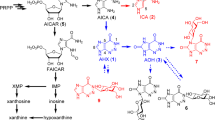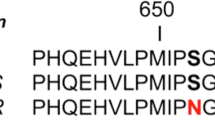Abstract
IT has been shown on numerous occasions that the transformation of a normal cell into a crown-gall cell takes place within a period of time which is limited to a few days after infection by Agrobacterium tumefaciens1. In earlier investigations I showed that the effectiveness of bromuracil2 and of 5-fluorodeoxyuridine (FUDR)3 in inhibiting this transformation is also limited to this period. From these results I concluded that the inhibition applies exclusively to the process of transformation of the host cells and not to the growth of the tumour. In this connexion, strong evidence is provided by experiments in which the inhibition is eliminated by thymidine (TDR). Mennigmann and Szybalski4,5 have shown that once an inhibition is completed by FUDR it is irreversible if FUDR is allowed to act unhindered for a sufficient length of time and hence for defective molecules of DNA to be formed. A similar mechanism also seems to be present in higher plants6. Thus if an inhibition produced by FUDR is no longer capable of being reversed by TDR after five days, it may be due to the fact that either the processes which can be blocked by FUDR have come to an end at this instant, or the inhibition produced by FUDR is no longer reversible. In order to decide which of these alternatives is the correct one it was necessary to choose an experimental approach which could show the selective action of FUDR on the development of a crown gall with the FUDR acting for a constant length of time during the process of transformation.
This is a preview of subscription content, access via your institution
Access options
Subscribe to this journal
Receive 51 print issues and online access
$199.00 per year
only $3.90 per issue
Buy this article
- Purchase on Springer Link
- Instant access to full article PDF
Prices may be subject to local taxes which are calculated during checkout
Similar content being viewed by others
References
Braun, A. C., and Stonier, T., Protoplasmatologia, 10, 5, 1 (1958). Stapp, C., Angew. Bot., 37, 103 (1963).
Bopp, M., Z. Naturforsch., 16b, 336 (1961).
Bopp, M., Z. Naturforsch., 19b, 64 (1964).
Mennigmann, H. D., and Szybalski, W., Biochem. Biophys. Res. Comm., 9, 398 (1962).
Mennigmann, H. D., and Szybalski, W., Bact. Proc., 43 (1962).
Bopp, M., and Lobsien, G., Exp. Cell Res. (in preparation).
Braun, A. C., Amer. J. Bot., 34, 234 (1947); Ann. Rev. Plant Physiol., 13, 533 (1962).
Bopp, M., Z. Naturforsch., 20b (in the press).
Rasch, E., Swift, H., and Klein, R. M., J. Biophys. Biochem. Cytol., 6, 11 (1959).
Kupila, S., and Stern, H., Plant Physiol., 36, 216 (1961).
Woodward, J., Rasch, E., and Swift, H., J. Biophys. Biochem. Cytol., 9, 445 (1961).
Author information
Authors and Affiliations
Rights and permissions
About this article
Cite this article
BOPP, M. Time Factor in the Action of 5-Fluorodeoxyuridine on the Development of Crown-galls. Nature 207, 83–84 (1965). https://doi.org/10.1038/207083a0
Issue Date:
DOI: https://doi.org/10.1038/207083a0
This article is cited by
-
Transformation of protoplast-derived cell colonies and suspension cultures by Agrobacterium tumefaciens
Plant Cell Reports (1985)
-
Beeinflussung der Zellstreckung durch 5-FUDR
Die Naturwissenschaften (1965)
-
Hemmung der Wurzelbildung an Etiolierten Erbsenepikotylen Durch Bromuracil und Histon
Planta (1965)
Comments
By submitting a comment you agree to abide by our Terms and Community Guidelines. If you find something abusive or that does not comply with our terms or guidelines please flag it as inappropriate.



